All Aboard! Building the Great Railroads with Railway Empire
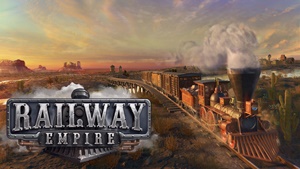
While I prefer fantasy games, and sometimes, shooters, I’m also a fan of strategy and simulations (sims). As is the case for many folks, SimCity was one of the first I really dove into. Now, you might have read my post on a show I really, really, liked: Hell on Wheels. It was a hard boiled, fictional take on the building of the Trans-Continental RailRoad. You should go read it now, if you haven’t already. I said, NOW! ?
A game that took up a lot of my time, when I wasn’t swinging a sword and hunting down dragons, was Railroad Tycoon, developed by the legendary Sid Meier. It’s been a while now, and I can’t recall if it was Tycoon 1, or it’s follow-up, Railroad Tycoon 2, which I sunk most of my time into. But regardless, I thoroughly enjoyed laying out routes and successfully completing scenarios. Even in open-ended RPGs, I’m very much a ‘check the box’ kind of player.
I didn’t play Railroad Tycoon 3, so I was done with railroad sims for over a decade. Then, a few months ago, I discovered Railway Empire, which came out in early 2018. And I found the love I had for railroad sims, rekindled. It’s from Kalypso, the folks behind the enjoyable and successful Tropico series. I played a couple of the earlier versions of that franchise, and I really liked being the dictator of a banana republic.
(I REALLY suggest you click on the images to see the details in this post. It helps sell the game)
The game is set in America, between 1830 and 1930, with a couple different play modes. The Campaign Mode has required goals to accomplish by specific dates, with additional optional goals. If you fail to accomplish any mandatory goals, you fail. Succeed, and you can move on to the next Campaign scenario. They do not build on each other. The Campaign itself is not interconnected. You ‘start over’ for each one. Which is fine, I guess. You jump back and forth in time. A connected campaign isn’t as important in a railroad sim, as it is in an RPG.
The Free Mode is more open world, with goals to accomplish by certain dates, but you don’t fail the entire thing if you miss one (or all!) of them. You can decide what order to tackle them in. Or, you can ignore them all together and just play. You still use money to buy resources. In Sandbox Mode, there’s no money and no restrictions. You just play however you want, however long you want to.
The map is divided into regions in which the Campaign scenarios take place. For example, in the third or fourth one, you start out in the South near the end of the Civil War. And the first scenario (which is the tutorial) takes you across the Great Plains. Downloadable content has added France, Germany, Great Britain and Ireland, Crossing the Andes, Mexico, and the Great Lakes.
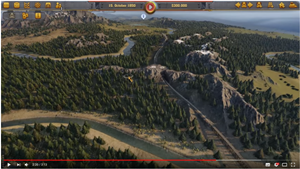
I’ve mostly played the Campaign Mode, with scenarios taking some work, but being accomplishable. I’ve also done a couple scenarios in Free Mode, and it wasn’t too bad. One went on nearly a hundred years, which is WAY too long, and by the time I had bought out all my competitors and connected every city on the map, I was a bit bored and abandoned it. But other scenarios are shorter.
Aiming to achieve your goals, which could be to connect Lincoln to Salt Lake City, or move two thousand passengers from Washington to New York City, or generate $250,000 in revenue from transporting mail – whatever you need to accomplish – you build stations, lay tracks, and get trains running on routes. That’s the heart of the game. Everything else is trimming related to that. And it’s darn fun!
You build a station (they are different sizes, which impact the number of tracks available, and how fast they help your city grow) to access a city. Also, you need a station at a business to access its goods. So, if Cheyenne needs beef, to turn into meat, which is an industry in that city, you would find a cattle farm nearby, build a station, and run a train from there (say, Johnson City) to Cheyenne. And it will deliver the needed product. Generating you income.
Likewise, you’ll find a way through the mountains to build a route from Baltimore to Pittsburgh, and then carry passengers, and mail, between the two cities. You can use side-tracks, and switches, to run multiple trains on the same tracks. Do it wrong, and you’ll find trains just sitting in stations and on tracks, not running. And not making you money!
You click on a station and lay down the track to a connecting point at another station. Then you can manipulate the track to find the fastest, and cheapest, route. If you can decrease the grade from 10% to 5%, that makes a difference in your train’s speed, and the cost of the track. Push the route west a bit and go around the foothills, rather than through. And try to avoid tunnels through the mountains: Oof!
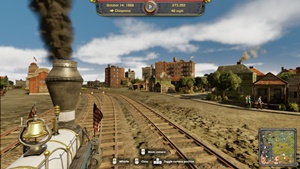
Once you have a route, assign a train to it. The game has some technology trees. I pretty much only use the one that includes the trains, not the ‘Business’ one. Because as you pick technologies in one era, you can unlock faster, more powerful, more reliable trains. And you usually need a certain number of technologies in that era to get to the next train. There are a LOT of trains. In my Free Mode ‘The West’ game I’m playing, there are forty trains you can upgrade to. Some are better for freight, some for express trains. And they have different speeds, reliability, and traction (the ability to go up grades). It’s not worthwhile to try and get every train (you spend Research points – Technologies cost 100, 200, or 300 points), but better trains make you money. You can upgrade your existing trains based on a price differential, so it’s an ongoing activity.
Having laid track and picked a train, you select the stations for the route. You can specify freight, passengers/mail, or a mix of both. I usually let the game pick the best cargo, unless I specifically need something related to a goal. And your train begins running and making you money.
You need to strategically lay your routes, and decide what businesses to incorporate. Your cities have demands, and if you meet them with goods, they grow. Bigger cities mean you make more money, generally. Sometimes, growing a specific city is a goal.
You have competitors, and they might put stations in city locations that block your ability to make the best routes. And you decide whether to upgrade your existing station in a city, add a second, smaller one, buy an industry in a city, add more routes to it: it’s both tactical and strategic.
You manage your company, not just your routes. When you just have to have some cash, you can issue debt, which of course, you have to repay with interest. You hire Engineers, Conductors, Stokers, and Security Guards, for your routes. They offer benefits, like increased top speed, or giving a 5% increase in freight revenues, for example.
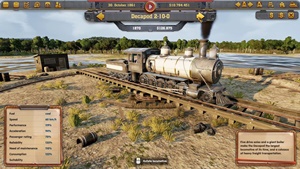
Employees have personality types, and if they align, you get additional bonuses. If they conflict, you get a negative. So, you might fire somebody, or move them to another route, when they don’t’ get along. It’s fun.
There are other types of employees you can hire. Like a reporter, who will run negative ads on a competitor to reduce their stock value – useful when you are trying to take them over! Or a surveyor, who reduces the cost of laying track through tunnels, etc. You don’t have to have employees, but they help. And some of the technologies relate to employees.
There are auctions that pop up, which allow you to buy a technology for cash, instead of technology points. That can be useful. Also, businesses come up for auction. You can take ownership. Which probably makes you want to make sure they’re connected to your network, to generate more money.
You can buy out your competitors (There is no multiplayer – opponents are PC bots, with individual personalities) and incorporate their routes and trains, or liquidate them. That’s kind of fun either way.
Visually, it’s a nice-looking game. I’m generally in the ‘on high’ overview mode, seeing where I need to go and what problems my trains are having. It’s like looking at a battlefield map from on high – functional, with some aesthetics. But you can zoom down and see things up close. It’s cartoony, but it looks good. There are people walking along at your stations, you can see the railway bridges, and at a certain angle, you get a 3-D look at the terrain, which I like, though I can’t manage my routes that way. You can read the names of the stations and see the cotton in the fields.
There’s also a ‘ride-along’ camera view. You can see the forward view from the Engineer, the rear view, and off to the sides of the train. There’s no point to it, but it’s really cool. I like watching trains chug along through different terrains, pass other trains, and pull into stations.
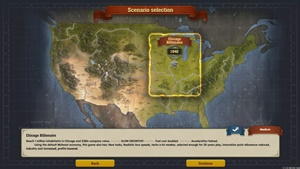
The terrain near Salt Lake City looks a lot different than that near Portland, or Atlanta, or New York City. The modeling is nicely done in this game.
It can seem a little hard on the Normal setting, but I figure, the fun is in the playing of a sim, not just in the winning (the latter always being my goal in RPGs). So, I restart and try again. The tutorial is VERY helpful. I’ll contrast that with Crusader Kings 2, which I recently picked up. That game has got a steep learning curve and very little tutorial help.
I did watch a couple YouTube ‘How To’ videos and they helped me a LOT in learning the game. I didn’t know you could adjust the layout of the tracks until my third campaign game. I just laid down the tracks and paid the price. Yeah – No wonder I lost my very first game.
If you like railroad sims, or sims in general, you should give this a try. I got it on sale, and it was well worth the price. Kalypso is a well-established company with a history of not abandoning their games, so I expect this to be supported for some time. And the DLCs they’ve added already seem to back that up.
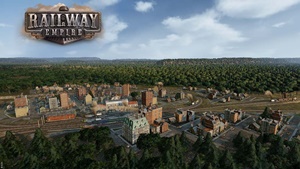
This game isn’t about micromanaging each route. There are tactical level decisions. But once a route is set up, and you’ve got a good train on it, the right cargo, and a supply tower (every route needs one or your trains break down), you can pretty much let a route ‘run itself.’ Adding employees to the route is usually a good idea, when you can.
But it’s really a strategy-level game, building routes to accomplish your goals, deciding what technologies to pursue, and how, if at all, to deal with competitors.
I’ve rediscovered my love of railroad simulations with this game. It’s just as fun to play as Railroad Tycoon was. I highly recommend this if it’s your type of game.
I’ll add that there’s a game called Railroad Corporation in early access that looks like it will be worth checking out in the future. It includes multiplayer, and recently added a Sandbox Mode, so it’s got different options while still being in development. It seems to be more of a micromanaging game. But I’m having a lot of fun with Railway Empire, and I’ll be getting some of the DLC and expanding my gameplay.
Other game (non-RPG)-related posts I’ve done here at Black Gate:
Dungeons and Dragons Adventure Game System
D&D Adventure Game System – The Temple of Elemental Evil Play Through
Munchkin!
Runebound
Runebound – The Sands of Al-Kalim
Runebound – The Mists of Zangara
Sherlock Holmes: Consulting Detective
221B Baker Street: The Master Detective Game
Conan: Age of Exiles
Mount & Blade/Warband – Part One
Mount & Blade/Warband – Part Two
 Bob Byrne’s ‘A (Black) Gat in the Hand’ was a regular Monday morning hardboiled/pulp column from May through December of 2018. And it returns later this month!
Bob Byrne’s ‘A (Black) Gat in the Hand’ was a regular Monday morning hardboiled/pulp column from May through December of 2018. And it returns later this month!
His ‘The Public Life of Sherlock Holmes’ column ran every Monday morning at Black Gate from March, 2014 through March, 2017 (still making an occasional return appearance!).
He organized ‘Hither Came Conan,’ as well as Black Gate’s award-nominated ‘Discovering Robert E. Howard’ series.
He is a member of the Praed Street Irregulars, founded www.SolarPons.com (the only website dedicated to the ‘Sherlock Holmes of Praed Street’) and blogs about Holmes and other mystery matters at Almost Holmes.
He has contributed stories to The MX Book of New Sherlock Holmes Stories – Parts III, IV, V and VI.
And he contributed to The New Adventures of Solar Pons.